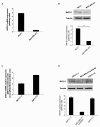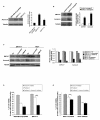ZNF217 confers resistance to the pro-apoptotic signals of paclitaxel and aberrant expression of Aurora-A in breast cancer cells
- PMID: 21059223
- PMCID: PMC2996367
- DOI: 10.1186/1476-4598-9-291
ZNF217 confers resistance to the pro-apoptotic signals of paclitaxel and aberrant expression of Aurora-A in breast cancer cells
Abstract
Background: ZNF217 is a candidate oncogene located at 20q13, a chromosomal region frequently amplified in breast cancers. The precise mechanisms involved in ZNF217 pro-survival function are currently unknown, and utmost importance is given to deciphering the role of ZNF217 in cancer therapy response.
Results: We provide evidence that stable overexpression of ZNF217 in MDA-MB-231 breast cancer cells conferred resistance to paclitaxel, stimulated cell proliferation in vitro associated with aberrant expression of several cyclins, and increased tumor growth in mouse xenograft models. Conversely, siRNA-mediated silencing of ZNF217 expression in MCF7 breast cancer cells, which possess high endogenous levels of ZNF217, led to decreased cell proliferation and increased sensitivity to paclitaxel. The paclitaxel resistance developed by ZNF217-overexpressing MDA-MB-231 cells was not mediated by the ABCB1/PgP transporter. However, ZNF217 was able to counteract the apoptotic signals mediated by paclitaxel as a consequence of alterations in the intrinsic apoptotic pathway through constitutive deregulation of the balance of Bcl-2 family proteins. Interestingly, ZNF217 expression levels were correlated with the oncogenic kinase Aurora-A expression levels, as ZNF217 overexpression led to increased expression of the Aurora-A protein, whereas ZNF217 silencing was associated with low Aurora-A expression levels. We showed that a potent Aurora-A kinase inhibitor was able to reverse paclitaxel resistance in the ZNF217-overexpressing cells.
Conclusion: Altogether, these data suggest that ZNF217 might play an important role in breast neoplastic progression and chemoresistance, and that Aurora-A might be involved in ZNF217-mediated effects.
Figures









Similar articles
-
Adenovirus-mediated Aurora A shRNA driven by stathmin promoter suppressed tumor growth and enhanced paclitaxel chemotherapy sensitivity in human breast carcinoma cells.Cancer Gene Ther. 2012 Apr;19(4):271-81. doi: 10.1038/cgt.2011.89. Epub 2012 Jan 27. Cancer Gene Ther. 2012. PMID: 22281755
-
The transcription factor ZNF217 is a prognostic biomarker and therapeutic target during breast cancer progression.Cancer Discov. 2012 Jul;2(7):638-51. doi: 10.1158/2159-8290.CD-12-0093. Epub 2012 May 10. Cancer Discov. 2012. PMID: 22728437 Free PMC article.
-
ZNF217, a candidate breast cancer oncogene amplified at 20q13, regulates expression of the ErbB3 receptor tyrosine kinase in breast cancer cells.Oncogene. 2010 Oct 7;29(40):5500-10. doi: 10.1038/onc.2010.289. Epub 2010 Jul 26. Oncogene. 2010. PMID: 20661224 Free PMC article.
-
Amplification of zinc finger gene 217 (ZNF217) and cancer: when good fingers go bad.Biochim Biophys Acta. 2007 Jun;1775(2):333-40. doi: 10.1016/j.bbcan.2007.05.001. Epub 2007 May 22. Biochim Biophys Acta. 2007. PMID: 17572303 Review.
-
Src family kinases and paclitaxel sensitivity.Cancer Biol Ther. 2011 Aug 15;12(4):260-9. doi: 10.4161/cbt.12.4.16430. Epub 2011 Aug 15. Cancer Biol Ther. 2011. PMID: 21646863 Free PMC article. Review.
Cited by
-
Exploring the Significance of the Exon 4-Skipping Isoform of the ZNF217 Oncogene in Breast Cancer.Front Oncol. 2021 Jul 2;11:647269. doi: 10.3389/fonc.2021.647269. eCollection 2021. Front Oncol. 2021. PMID: 34277402 Free PMC article.
-
A functional interplay between ZNF217 and estrogen receptor alpha exists in luminal breast cancers.Mol Oncol. 2014 Dec;8(8):1441-57. doi: 10.1016/j.molonc.2014.05.013. Epub 2014 Jun 10. Mol Oncol. 2014. PMID: 24973012 Free PMC article.
-
Zinc finger gene 217 (ZNF217) Promoted Ovarian Hyperstimulation Syndrome (OHSS) through Regulating E2 Synthesis and Inhibiting Thrombospondin-1 (TSP-1).Sci Rep. 2017 Jun 12;7(1):3245. doi: 10.1038/s41598-017-03555-6. Sci Rep. 2017. PMID: 28607476 Free PMC article.
-
Information-dependent enrichment analysis reveals time-dependent transcriptional regulation of the estrogen pathway of toxicity.Arch Toxicol. 2017 Apr;91(4):1749-1762. doi: 10.1007/s00204-016-1824-6. Epub 2016 Sep 3. Arch Toxicol. 2017. PMID: 27592001 Free PMC article.
-
MicroRNA-125b upregulation confers aromatase inhibitor resistance and is a novel marker of poor prognosis in breast cancer.Breast Cancer Res. 2015 Jan 30;17(1):13. doi: 10.1186/s13058-015-0515-1. Breast Cancer Res. 2015. PMID: 25633049 Free PMC article.
References
-
- Quinlan KG, Verger A, Yaswen P, Crossley M. Amplification of zinc finger gene 217 (ZNF217) and cancer: when good fingers go bad. Biochim Biophys Acta. 2007;1775:333–340. - PubMed
-
- Collins C, Rommens JM, Kowbel D, Godfrey T, Tanner M, Hwang SI, Polikoff D, Nonet G, Cochran J, Myambo K. et al.Positional cloning of ZNF217 and NABC1: genes amplified at 20q13.2 and overexpressed in breast carcinoma. Proc Natl Acad Sci USA. 1998;95:8703–8708. doi: 10.1073/pnas.95.15.8703. - DOI - PMC - PubMed
Publication types
MeSH terms
Substances
LinkOut - more resources
Full Text Sources
Other Literature Sources
Medical
Miscellaneous

